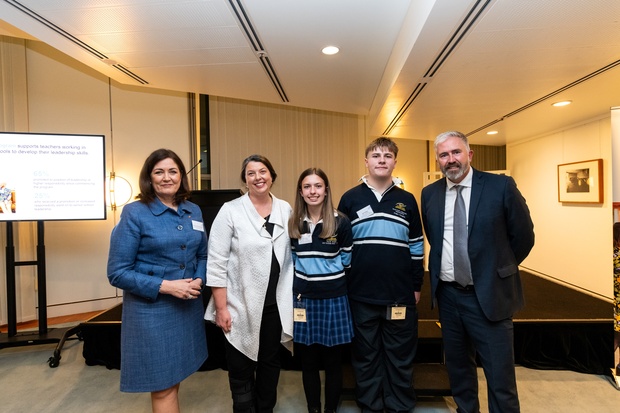Now the charity’s founder and CEO says the longstanding animosity is unwarranted, unfounded, and reveals a gross ‘misunderstanding’ of data and impact of the teacher training program.
Speaking with EducationHQ, Melodie Potts Rosevear OAM, said the steady criticism cast by the Australian Education Union (AEU) over more than a decade “just doesn’t make sense”.
“It feels like there’s a lot more that unites us: we actively encourage all of our participants to join the union.
“We’re vocal about that, and yet 15 years on, their opposition to us remains…”
The AEU recently slammed the Federal Government’s decision to fund an extra 475 places in TFA – the most out of nine other teacher training providers.
“Recruiting unqualified and inexperienced TFA associates to teach in the most disadvantaged communities is not just counterintuitive, it is damaging for all concerned, with the evidence showing that such ‘fast-track’ programs are wasteful, inefficient and undermine both the quality and retention of the teaching profession,” the union said in a statement.
But Potts Rosevear said the singling out of TFA when other providers were now also offering employment-based pathways into teaching was perplexing.
“I honestly don’t understand it, and if they would agree to meet with us, which we repeatedly ask for and repeatedly get turned down on, maybe we could come to some sort of an understanding about what’s not true in the representation of what we do and why we do it…”
According to Potts Rosevear, the union’s stance reflects a broader misunderstanding about TPA’s core purpose: to recruit those who might not otherwise have chosen to pursue a career in teaching into the profession, and place them in disadvantaged schools while they work to complete their degree.
“We’re so much more aligned than not,” she argued.
“I think it’s a misunderstanding of … the work that we do in schools, where principals are so happy to have us and where our participants are actively flying the good flag.”
Of particular issue to the union is the idea that TFA essentially offers a shortcut into the classroom.
Potts Rosevear said this could not be further from the reality.
“I encourage them to ask any of our participants whether they think they’ve been fast-tracked and whether they think [the program’s] a shortcut.
“I mean, they are doing just as much, if not more, than any other person coming into the teaching profession: 500 days of practicum versus 60 in traditional postgraduate pathways.
“This is an employment, school-based and situated teacher education program – and it has proven results, so much so that there are now additional providers following suit in some way, shape or form.
“So, this is not a ‘fast track’ – it takes them longer than two years to complete their degree,” she added.

Education Minister Jason Clare, pictured with TFA alumni and Potts Rosevear, celebrated the program's 15th anniversary at Parliament House in Canberra.
Recently the union flagged Senate Estimates data that it said showed just over half of all TFA graduates are still working in schools, and that “TFA’s own data shows that just 41 per cent are working as teachers”.
But Potts Rosevear said this analysis was selective and failed to mention comparative ITE statistics.
“We know, and government figures are very clear, that only around 69 percent of people who start a postgraduate pathway of teaching finish.
“And only 49 percent of those who start an undergraduate pathway finish. And of those only around .... two-thirds go on to teach. So you've got massive leakage, big leaky bucket [with] the traditional pathways,” she contended.
Some 90 per cent of TFA participants go on to complete the program, she noted.
“That means they’re also teaching for two years, they’re meeting the need of schools and students for two years as part of the design of the program, and then we know that a large majority of them stay on.
“So it’s just a bit clever to not create a comparison.”
The union have also claimed that TFA graduates are leaving schools in the disadvantaged communities they were intended to help.
This is simply not accurate, Potts Rosevear countered.
“What we know is that overall, 85 per cent of our alumni are still in education. Over 70 per cent of them are still teaching.
“When you look at those still teaching, we know that over half of those are in what we would call ‘eligible schools’, so lower ICSEA schools.
“And we know that a third of those alumni who are still teaching are in rural and regional and remote locations, which need them even more,” she said.
Undercutting the AEU’s criticism is also the fact that most of TFA’s graduates would not have pursued teaching in the first place without the program, Potts Rosevear noted.
“We are adding people to the profession. We are adding people to the union’s membership.
“We are adding talent into schools that are crying out for them, where principals overwhelmingly, over 95 per cent say, ‘We want more of them, please!’”
Potts Rosevear said TFA was the most evaluated, transparent and union-aligned teacher pathway available. She called on the union’s blame game to cease
“Now, is our program perfect? I would be the first to say no.
“There are always ways we can improve … but this rhetoric needs to stop. It doesn’t help the profession that is crying out for more people to join it…
“We are aligned on so many things – and I want us to find a way through. I really, really do.
“The trope is old. Just let’s move on.”














